
The settlement of Japanese people in southern Alberta is a very interesting and complicated story. When Japanese settlers came to southern Alberta they faced many challenges and hardships, yet, they have still managed to flourish.

A traditional Kimono Robe worn by Japanese women. Courtesy of "Education Collection"
The first Japanese to come to Canada arrived on the coast of British Columbia during the 1880's. They were mostly unskilled labourers who worked in the fishing, logging, and mining industries. The Japanese settlers did not come to southern Alberta until many years later. As early as 1903, approximately 20 Japanese moved to the Raymond area to work at the Knight Sugar Factory. By 1907 arrangements were made for 1000 Japanese workers to be brought to southern Alberta in order to work on the new irrigation project already underway. Public opposition to the proposal canceled the idea and only a few Japanese workers ended up working on the project. More opposition to Japanese settlement arose when the C.P.R. used Japanese workers during a mechanic’s strike in 1909. Even though they were not liked, a small number of Japanese workers continued to come to southern Alberta in search of employment. Between 1911 and 1914 over fifty these Japanese men found work in the mines around Lethbridge.
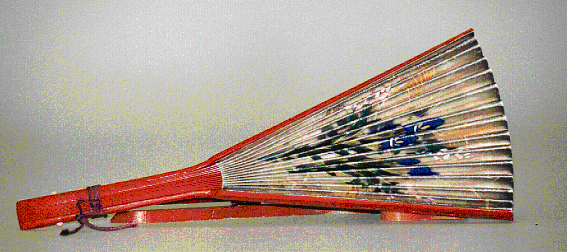
Traditional fan used in many different ceremonies.
These first immigrants became well-established in the communities of Raymond and Hardieville. By 1914 the Japanese community in Raymond established the Nihonjin Kyokai or The Raymond Japanese Society. The society was set up to provide mutual assistance for Japanese immigrants, facilitate the immigration of more Japanese workers, and create better relations with the rest of the community. The Japanese community showed that they could look after itself and still be responsible members of the community. As work in the mines began to disappear in the late 1920's, many of the Japanese people living in Hardieville began to move onto small farms in the Lethbridge and Coaldale area. In 1929, the Raymond Buddhist Church was started and it would become the center of social life for the Japanese community in southern Alberta for many years.
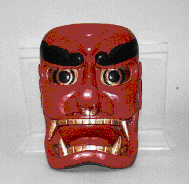
"Tenga No Men" Mask. The mask was the mascot of the Tenga Noodle Restaurant owned by the Kikumatsu Nakahama family in Vancouver in 1934. Tenga No Men is a Shinto long nosed goblin mask, signifying plenty.
At the end of 1920's, the Japanese community was growing and had become strong members of the community where they lived and worked. During the 1930's the drought and depression caused some problems for the Japanese in southern Alberta. Everyone suffered economically because of a lack of jobs. The Japanese Canadians who did find work were accused of stealing work from ‘white Canadians’. The situation became especially serious when World War II began. In this conflict Canada was at war with both Germany and Japan.The situation worsened after the Japanese bombing of Pearl Harbor in 1941. Very few Japanese-Canadians had any sympathy for the Japanese war effort and most either stayed way from the conflict or supported the allied effort. This did prevent many Canadians from seeing the Japanese people in Canada as a serious threat to national security. In southern Alberta relations between the Japanese and their neighbors remained quite friendly. A number of Japanese-Canadians from southern Alberta even joined the Canadian armed forces - something that was not allowed in other parts of the country. Relations between the Chinese and Japanese communities in Lethbridge, however, had become quite tense. Japanese customers were often denied service in Chinese businesses because of the Chinese community wanted to distance itself from the Japanese.
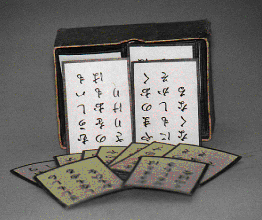
Japanese Card Game. The game is called "ogura-hyakunin isshu". It is played by matching one card from one deck to a card from the other deck on the basis of the songs printed on the cards and sung out by the players.
Attitudes toward Japanese-Canadians in British Columbia were far less tolerant. The Japanese-Canadians were not very well liked and were seen as unwilling to mix into Western society. With the outbreak of war with Japan in 1941, people were scared that the Japanese would attack or even invade the coast of British Columbia. Japanese-Canadians living in the area were seen as possible spies or traitors. After a series of measures that limited the rights of Japanese-Canadians on the west coast failed to satisfy some British Columbians, the government created a 100 mile-wide strip of land along the coast where no people of Japanese descent could go. This left the B.C. Security Commission, which was responsible for the evacuation of the west coast, with the problem of where to move the thousands of Japanese people. In the months that followed, many Japanese-Canadians were sent to the interior of British Columbia.
At the same time that this was happening in British Columbia, southern Alberta didn’t have enough workers for the sugar beet industry because so many young men were fighting in the war. The beet growers of southern Alberta saw the Japanese evacuees as possible workers, and they proposed that the evacuees be brought to southern Alberta. Many people disliked this plan because they thought that the presence of Japanese-Canadians would be dangerous. But by early in the spring of 1942 the plans were in place to bring Japanese families from British Columbia to the sugar beet fields of southern Alberta. Later that year approximately 2250 Japanese-Canadians arrived in southern Alberta, adding to the 500 Japanese who already lived in the area. Because most of these first arrivals were from the Fraser Valley, they were already experienced with agricultural work. To take advantage of these skills they were placed on farms and supplied with housing.
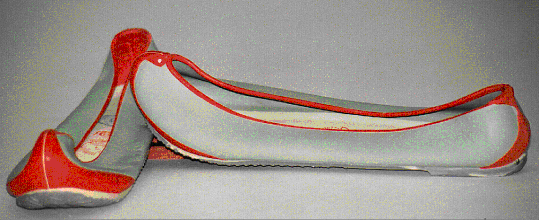
P19739434000-GA Women's slippers from Korea, brought to Lethbridge in the 1970's.
But there were many problems. The housing provided for the evacuees was often intended for summer workers and was not warm enough for winter use.The Japanese workers often did not have running water in these houses for drinking, cooking, and cleaning.
Another problem was the fact that Japanese families were sometimes not given enough land to work. Since they were not allowed to find work on other farms or in town, these families were often unable to make enough money to live. What was even more difficult was that the province only provided free education until the seventh grade for Japanese students, forcing their parents to pay the full cost of a high school education out of their own pockets.
Despite these difficulties, the Japanese evacuees were quite successful. Providing over 65% of the sugar beet field labour in southern Alberta, they were seen by most people as having saved the sugar industry in southern Alberta. As time went on, the original mistrust and fear that people felt for the Japanese evacuees went disappeared, and they were given more and more freedom. They were allowed to look for work on the farms of their choice, and some of them were able to find work during the winter in saw mills or canneries. The success of the Japanese evacuees and the growing respect and trust shown to them by the rest of the community were partly the result of their own hard work and honesty. The evacuees were also helped by the presence of the Japanese ‘old-timers’ who had lived in southern Alberta for decades. These old-timers provided a great deal of support for the evacuees, while at the same time showing the rest of the community how it was possible for Japanese people to be good neighbors and citizens. At the end of the war, there were not many people who wanted to have the Japanese evacuees removed from southern Alberta. They were asked if they wanted to return to Japan, but of the thousands of Japanese people in southern Alberta only nine returned to Japan. Most of the evacuees did not even return to British Columbia. In 1949 all of the anti-Japanese war-time laws were removed and all Japanese-Canadians were allowed to buy property and move freely around the country.
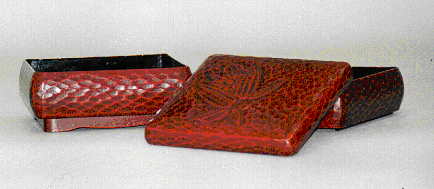
Three layer serving tray used on special occasions in Japan.
Since then the Japanese in southern Alberta have played an important role in the area’s development. They have been successful farmers in the areas around Picture Butte, Coaldale, Taber, and Raymond. Many Japanese people in southern Alberta of the second and third generations (Nisei and Sansei) have also obtained high levels of education, often moving into different professions. The Japanese community has also become a part of the wider community. Many of them have joined various Christian churches and marriage between Japanese and non-Japanese people is quite common. The wider community has also shown an increased appreciation and respect for Japanese culture as is demonstrated by the construction of the Nikka Yuko Japanese Garden in Lethbridge. Finally, there has also been an attempt to apologize for the treatment of Japanese evacuees during and after World War II. The federal government has begun to pay back those who had their land and property taken away, and has apologized for the anti-Japanese measures that were instituted during the war.
Previous Page | Exhibit Contents | Home | Navigation Information | Glossary | Curriculum Guide | Next Page
Copyright © 1996 Sir Alexander Galt Museum. All rights reserved.